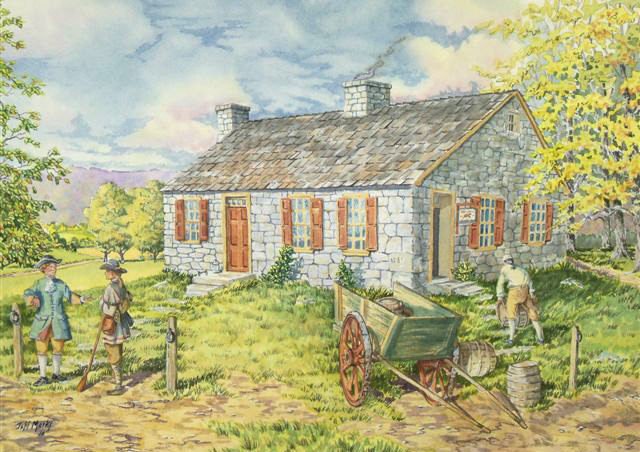Artist Jeff Marks
Ethnic Association: The house was originally built as a one story building with limestone construction. Cursory investigation would seem to suggest a floor plan associated with Scotch-Irish settlement in Pennsylvania. According to Jerry Clouse, who has surveyed numerous early vernacular buildings in southern and western Pennsylvania, the floor plan does seem to be exceedingly similar to several documented properties associated with 18th century Scotch-Irish settlement.
It appears the original layout included three rooms with two chimneys. These chimneys, unlike examples of many other Anglo influenced structures of the colonial era, are placed in a distinctive location. The south chimney has an exterior stack that projects from the wall of the house. This type of chimney construction is seen on occasional examples in south central Pennsylvania and western Maryland and can find precedent as far east as Chester County, PA. Although not a true walk-in fireplace, its large opening would seem to designate this hearth was for cooking.
The most unusual chimney in the house, however, is its center chimney. In Pennsylvania, center chimneys are most often thought to be associated with homes constructed by the Germanic Pennsylvania Dutch, however, the Smith house and at least one other location in West Pennsborough Twp. Cumberland County, PA at the Richard Woods house, also use this characteristic. Based on the size of the hearth opening, the Scotch-Irish center chimney differs in use from the PA Dutch version. Given its small size, the fireplace of this chimney is for heating. The Germanic style of center chimneys typically contain a large walk-in fireplace which was used for cooking.
Original Appearance: One of the questions that exists is what the original appearance of the house entailed, given that a second story was added in the early 20th century and to date no photographs of its pre-second story appearance have turned up.
The gable ends seem to be the most curious as to their original construction. Given precedent from architecture tradition of the time, these gable ends could have been constructed of frame with clapboards, or stone construction. Likewise, it is possible that the north end of the house did have a pent roof separating the first floor from the attic level (the south wall would not have had a pent roof due to the projecting chimney stack).
The current porch that wraps around three side of the house is likewise of more recent construction. Most likely, the Smith house had no porch whatsoever when first constructed. It is possible that there might have been a small, cantilevered, hood roof containing a gabled eave roof porch directly over the front and back doors.
Additional Investigation: The comments above were made primarily based on a visual inspection of the property in spring of 2010. Significant additional investigation will be required to determine the original characteristics of the Smith House
Chris Witmer, Vernacular Architecture Advisor
Jeff Marks (artist) grew up in Lancaster County PA, and discovered at an early age that he had a talent to draw and was tutored by the locally renowned artist, the late Jay McVey. After high school graduation he attended the Pennsylvania School of the Arts. In addition to art, Jeff has an avid interest in history and has been a Civil War Re-enactor for the past 31 years; living and portraying the lifestyle of this “crucial” time period of our nation’s history. Because of his love for both history and art, Jeff is known most for doing paintings that reflect a particular time and place. Jeff likes to add character and life to each scene by portraying people performing the tasks of the day. This is to give a sense of “history unfolding before the viewer’s eyes.”
Jeff is a strong advocate for preserving “our nation’s past”, and it is his hope that through his art as well as re-enacting, he will be an influence to someone
of the younger generation so that the past will not be forgotten.
